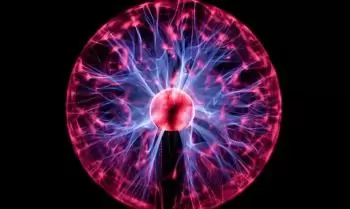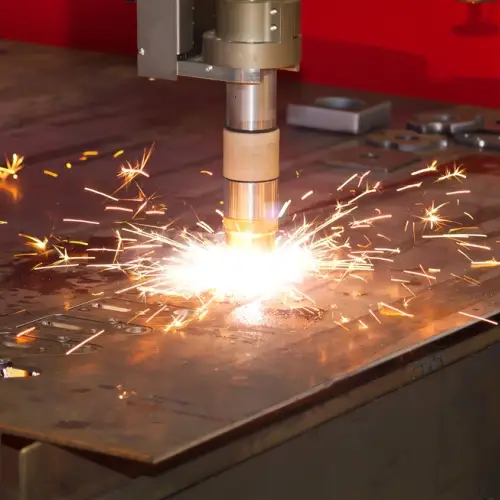
Plasma is a state of matter distinct from solid, liquid and gaseous states.
Plasma is characterized by an ionized gas in which atoms have lost or gained electrons, creating a mixture of positive ions and free electrons. In a broader sense, plasma can be composed of any charged particle, such as negative ions, electrons, and ionized atoms or molecules.
Transition to plasma
 Plasma is formed when a gas is heated to extremely high temperatures, sufficient to ionize atoms and molecules. This state is known as the fourth state of matter .
Plasma is formed when a gas is heated to extremely high temperatures, sufficient to ionize atoms and molecules. This state is known as the fourth state of matter .
Unlike solids, liquids and gases, plasma has no definite shape or volume. Its charged particles move freely, allowing plasma to respond to electric and magnetic fields.
Relationship with electricity
One of the distinctive properties of plasma is its ability to conduct electric current.
This is due to the presence of free electrons and ions in the plasma, which allow the plasma to act as a conductor. In addition, plasmas can generate their own electric fields and are highly influenced by magnetic fields .
This property makes plasma essential in various technological applications, such as in fluorescent tubes and neon lights , where electricity excites the gas inside the tube, producing visible light.
Relationship with nuclear fusion energy
 Nuclear fusion is the process in which two light atomic nuclei combine to form a heavier nucleus, releasing a large amount of energy in the process.
Nuclear fusion is the process in which two light atomic nuclei combine to form a heavier nucleus, releasing a large amount of energy in the process.
For nuclear fusion to occur, atomic nuclei must overcome an electrostatic repulsion barrier due to their positive charges. This requires that the atoms be kept at extremely high temperatures, on the order of millions of degrees Celsius, so that they can gain enough kinetic energy to overcome this repulsion and allow fusion to occur.
At these extremely high temperatures, the material is in the plasma state. In plasma, atoms are completely ionized, and charged particles (ions and electrons) move freely. This is crucial because fusion reactions require such high temperatures and pressures that atoms turn into plasma, allowing atomic nuclei to meet and fuse.
For nuclear fusion to be viable, the plasma must be confined and maintained at the necessary conditions. There are two main methods for confining plasma:
- Magnetic confinement : Uses magnetic fields to keep the plasma at high temperatures and prevent it from touching the walls of the container. Examples include the tokamak and the stellarator , which are experimental devices in which fusion is investigated.
- Inertial confinement : Uses lasers or other methods to heat and compress small samples of fusion fuel, creating the conditions necessary for fusion.
Maintaining a plasma at the right conditions for fusion is a significant technical challenge. Nuclear engineers must control the plasma's temperature, density, and confinement long enough for fusion reactions to occur effectively.
Differences with gaseous states
Although plasma shares some characteristics with the gaseous state, such as the lack of a defined shape and volume, there are key differences:
- Ionization : Unlike ordinary gases, in plasma the atoms are ionized, creating a mixture of ions and free electrons.
- Electrical Conduction : Plasma can conduct electricity and is sensitive to electric and magnetic fields, while neutral gases do not have this ability.
- Electromagnetic Interactions : Plasma interacts intensely with magnetic and electric fields, unlike gases which are less affected by these fields.
Plasma in the universe
Plasma is the most abundant state of matter in the universe. Most baryonic matter (composed of protons and neutrons) in the cosmos exists as plasma. All stars , including our sun, are composed of plasma. Even interstellar space, though very rarefied, contains plasma.
For example, Jupiter , the largest planet in the Solar System, contains a significant amount of matter in non-plasma forms (liquids, solids, and gases), but plasma is a crucial part of its composition and dynamics.
Even dust particles in outer space, which can carry an electrical charge, are considered part of the universal plasma. These particles can form complex plasmas composed of charged ions, contributing to the diversity and extent of plasma in the cosmos.
Examples of plasma
 Below we show some examples of plasma that can be of natural or artificial origin:
Below we show some examples of plasma that can be of natural or artificial origin:
- Stars and Sun : Stars, including the Sun, are composed primarily of plasma. Inside stars, extremely high temperatures cause atoms to ionize, creating a plasma that enables nuclear fusion reactions.
- Northern Lights and Southern Lights : These stunning light displays in the polar sky are caused by plasma. The solar wind, a plasma of charged particles, interacts with the Earth's atmosphere, ionizing gases and creating the auroras.
- Lightning : During a thunderstorm, lightning creates a plasma in the atmosphere. The electrical discharge ionizes gases in the air, generating a channel of hot, glowing plasma.
- Solar wind : The solar wind is a stream of charged particles (plasma) emitted by the Sun. These particles can interact with the magnetic field of the Earth and other planets, creating phenomena such as auroras.
- Neon lamps and fluorescent tubes : These lamps contain gases in a plasma state. When an electrical voltage is applied, the gas ionizes, producing light. Neon lamps emit a characteristic red light, while fluorescent tubes can emit a range of colors depending on the internal coatings.
- Plasma displays : Plasma displays, used in televisions and monitors, work by exciting ionized gases in cells within the screen, producing light to create images.
- Nuclear fusion in laboratories : Nuclear fusion experiments, such as those performed in tokamak and stellarator devices , confine a plasma at high temperatures to induce fusion reactions. These devices attempt to recreate the extreme conditions of stars in a controlled environment.
- Plasma Cutting : In industry, plasma cutting uses a high-temperature plasma jet to cut conductive materials, such as metals. Plasma is generated by ionizing a gas that is forced through a small orifice.
- Plasma Ball Lamps : These decorative lamps contain a plasma gas in a glass sphere. When a voltage is applied to electrodes inside the sphere, the gas ionizes and produces a visual spectacle of light discharges.
Northern lights
The northern lights (and southern lights) are natural examples of plasma.
These spectacular lights are generated when charged particles from the solar wind collide with atoms in the Earth's atmosphere. The solar wind, composed of a high-energy plasma, interacts with the Earth's magnetic field, causing the particles to be directed towards the poles.
When these particles collide with molecules in the atmosphere, they ionize gases, creating the stunning light displays known as auroras.